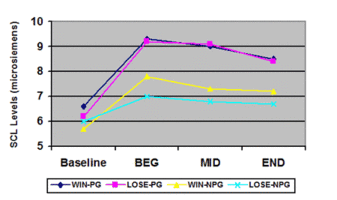“There’s an old French proverb that says, ‘The pleasure in gambling is winning and losing.’”
— Richard LaBrie, CNBC, 7/25/02.
Gamblers often speak of the “thrill of the game” when discussing their reasons for playing. Many people assume that occasional winning stimulates this thrill and that gamblers can become “addicted” to the feelings associated with this thrill. Evidence suggests that some gamblers have trouble restraining themselves from repeatedly gambling (Potenza et al., 2003); however, new research suggests that an inability to limit gambling might be related to increased arousal from any gambling experience, regardless of winning or losing. A recent study by Louise Sharpe investigates the possibility that problem gamblers are equally aroused by both wins and losses; this arousal motivates them to continue gambling despite adverse consequences (Sharpe, 2004).
Sharpe’s study sample consisted of 13 poker machine gamblers with a gambling problem and 20 control subjects. The problem gamblers had a South Oaks Gambling Screen (SOGS) score of 5 or greater; the control subjects had SOGS scores of less than 5. Researchers measured participants’ Skin Conductance Level (SCL) for the duration of the experiment using two, 2-mm silver electrodes on the left index and middle fingers. After a 12minute adaptation period to establish an SCL baseline, participants imagined one of two two-minute gambling scenarios. One scenario asked the subject to imagine a previous poker machine session where the participant WON. The other scenario asked the subject to imagine a similar scenario where the participant LOST. These scenarios were presented WIN then LOSE for half the participants and LOSE then WIN for the other half. Each two-minute scenario was broken up into three 40-second intervals, which marked the beginning, middle and end of each scenario. After each scenario, participants made subjective ratings of tension on a ten-point Likert scale.
As Figure 1 shows, both the WIN and LOSE scenario SCL scores for the problem gamblers were greater than the controls. An analysis of covariance (ANCOVA) using baseline SCL as a covariate and comparing levels of arousal between groups with repeated measures for outcome (winning and losing) revealed a main effect for group (F(1, 30) = 3.763, p < .04). Problem gamblers were aroused equally by WIN and LOSE scenarios; the controls were more aroused by WIN scenarios. For problem gamblers, researchers observed high correlations for SCL scores during the two scenarios for each of the three time periods (beginning: r = .919, middle: r = .954, and end: r = .923, all statistically significant, p < 0.001), but for controls, correlations were lower (beginning: r = .437, middle: r = .371, not statistically significant, and end: r = .446, p < 0.05). According to the self-reported tension ratings, non-problem gambling participants found the LOSE scenario more tense (F(1, 32) = 4.984, p < 0.03) than problem gamblers.
Figure 1: Graph of SCL Levels (microsiemens) at Baseline, at the Beginning (BEG), Middle (MID) and End of the Imaginal Scenarios (Sharpe, 2004).
Notes: WIN-PG = the winning scenario for the problem gambling group; LOSE-PG = the losing scenario for the problem gambling group; WIN-NPG = the winning scenario for the non-problem gambling group; LOSE-NPG = the losing scenario for the non-problem gambling group.
There are some limitations to this research. This study employed a small sample and researchers need to examine these results with a larger sample to determine if the findings are robust and generalizable. Because the study only tested participants imagining gambling wins and losses, there is no assurance that the participants imagined similar wins or losses. Some participants might have imagined greater wins or losses than other participants; and, this discrepancy might have affected the associated SCL scores.
Despite these concerns, this study provides some evidence showing that problem gamblers become aroused in response to both WIN and LOSE scenarios. This suggests that problem gamblers can become aroused by all facets of gambling, perhaps stimulating continued gambling even when they repeatedly lose. Future studies need to explore this theme with a greater and more diverse number of subjects and within a more realistic gambling environment. The finding that some gamblers are aroused by losing suggests that current and future treatments for gambling disorders include attention to the nature and extent of this phenomenon.
Comments on this article can be addressed to Mike Stanton.
References
Potenza, M. N., Steinberg, M. A., Skudlarski, P., Fulbright, mR. K., Lacadie, C. M., Wilber, M. K., et al. (2003). Gambling Urges in Pathological Gambling. Archives of General Psychiatry, 60(8), 828-836.
Sharpe, L. (2004). Patterns of autonomic arousal in imaginal situations of winning and losing in problem gambling. Journal of Gambling Studies, 20(1), 95-104.






Talan Stotts February 13, 2012
Talan Stotts
Very good blog.Thanks Again. Want more.